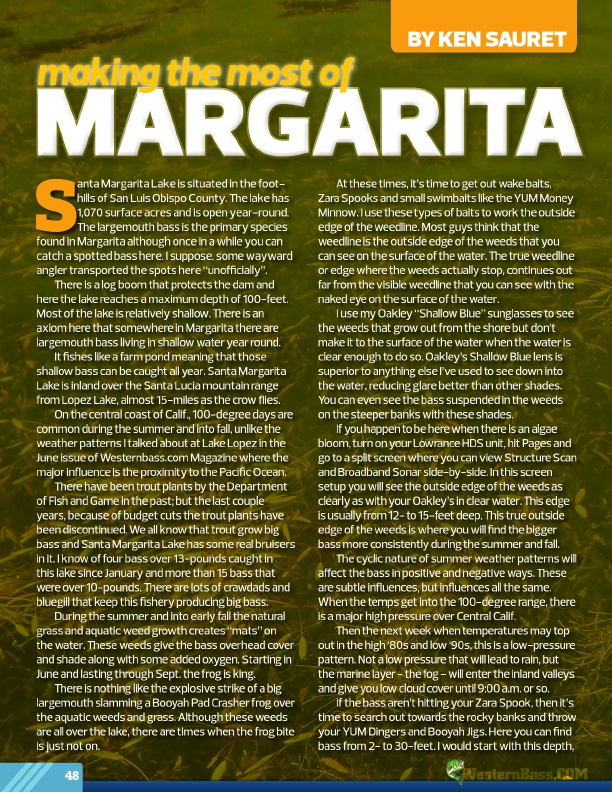
margarita
making the most of
anta Margarita Lake is situated in the foot- hills of San Luis Obispo County. The lake has 1,070 surface acres and is open year-round. The largemouth bass is the primary species found in Margarita although once in a while you can catch a spotted bass here. I suppose, some wayward angler transported the spots here “unofficially”. There is a log boom that protects the dam and here the lake reaches a maximum depth of 100-feet. Most of the lake is relatively shallow. There is an axiom here that somewhere in Margarita there are largemouth bass living in shallow water year round. It fishes like a farm pond meaning that those shallow bass can be caught all year. Santa Margarita Lake is inland over the Santa Lucia mountain range from Lopez Lake, almost 15-miles as the crow flies. On the central coast of Calif., 100-degree days are common during the summer and into fall, unlike the weather patterns I talked about at Lake Lopez in the June issue of Westernbass.com Magazine where the major influence is the proximity to the Pacific Ocean. There have been trout plants by the Department of Fish and Game in the past; but the last couple years, because of budget cuts the trout plants have been discontinued. We all know that trout grow big bass and Santa Margarita Lake has some real bruisers in it. I know of four bass over 13-pounds caught in this lake since January and more than 15 bass that were over 10-pounds. There are lots of crawdads and bluegill that keep this fishery producing big bass. During the summer and into early fall the natural grass and aquatic weed growth creates “mats” on the water. These weeds give the bass overhead cover and shade along with some added oxygen. Starting in June and lasting through Sept. the frog is king. There is nothing like the explosive strike of a big largemouth slamming a Booyah Pad Crasher frog over the aquatic weeds and grass. Although these weeds are all over the lake, there are times when the frog bite is just not on.
By Ken sauret
S
At these times, it’s time to get out wake baits, Zara Spooks and small swimbaits like the YUM Money Minnow. I use these types of baits to work the outside edge of the weedline. Most guys think that the weedline is the outside edge of the weeds that you can see on the surface of the water. The true weedline or edge where the weeds actually stop, continues out far from the visible weedline that you can see with the naked eye on the surface of the water. I use my Oakley “Shallow Blue” sunglasses to see the weeds that grow out from the shore but don’t make it to the surface of the water when the water is clear enough to do so. Oakley’s Shallow Blue lens is superior to anything else I’ve used to see down into the water, reducing glare better than other shades. You can even see the bass suspended in the weeds on the steeper banks with these shades. If you happen to be here when there is an algae bloom, turn on your Lowrance HDS unit, hit Pages and go to a split screen where you can view Structure Scan and Broadband Sonar side-by-side. In this screen setup you will see the outside edge of the weeds as clearly as with your Oakley’s in clear water. This edge is usually from 12- to 15-feet deep. This true outside edge of the weeds is where you will find the bigger bass more consistently during the summer and fall. The cyclic nature of summer weather patterns will affect the bass in positive and negative ways. These are subtle influences, but influences all the same. When the temps get into the 100-degree range, there is a major high pressure over Central Calif. Then the next week when temperatures may top out in the high ‘80s and low ‘90s, this is a low-pressure pattern. Not a low pressure that will lead to rain, but the marine layer - the fog - will enter the inland valleys and give you low cloud cover until 9:00 a.m. or so. If the bass aren’t hitting your Zara Spook, then it’s time to search out towards the rocky banks and throw your YUM Dingers and Booyah Jigs. Here you can find bass from 2- to 30-feet. I would start with this depth,
48